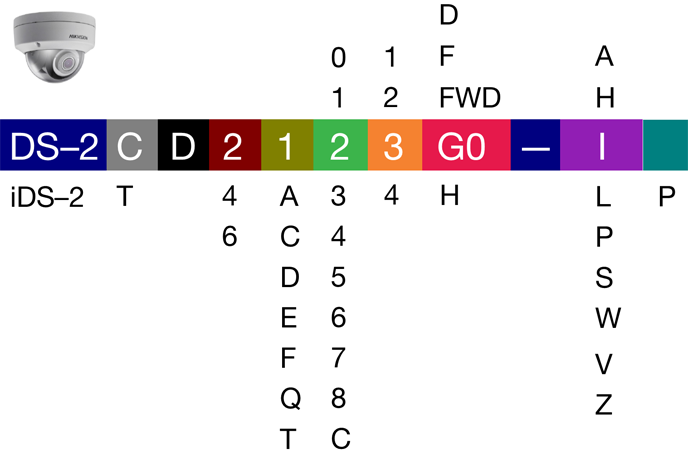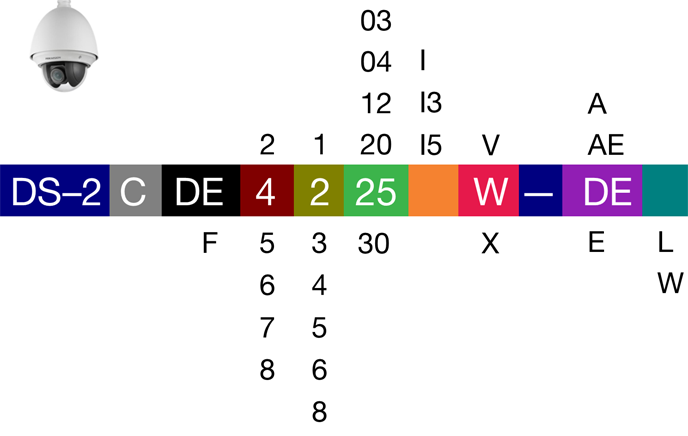Statement on Hikvision products
Since July 2021 we no longer supply Hikvision products due to ethical concerns (read more).Our recommended alternatives are Axis Communications, i-PRO, Bosch and Wisenet or see our IP Cameras category page. Call us on 0151 633 2111 or make an enquiry for further advice.
At first glance, the long Hikvision model numbers can look completely unintelligible. You're certainly not alone if they make you scratch your head and rely on the product description instead. This guide can help you penetrate the logic behind the string of letters and numbers.
The first thing to note is that the naming convention is slightly different depending on the type of product. The letters and numbers in the model number mean different things for static and PTZ cameras. It will all become clearer shortly.
Static cameras
The Hikvision static camera range varies from dome to bullet to turret (and more), and shares the same naming convention across models. The image below shows the possible variances at the moment:

Let's take one of the more complex products, in this case DS-2CD4A26FWD-IPZ-P to explore the meaning behind the code.
| Model # | What this means |
|---|---|
| DS-2 |
Hikvision
Intelligent products start iDS-2 |
| C |
C = Colour
T = thermal |
| D | IP camera |
| 4 |
2 = entry level
4 = project 6 = vehicle or specialist |
| A |
Type of camera:
Odd number = dome/turret Even number = box/bullet/cube/covert A = bullet C = cube/panda D = pinhole E = recessed-mount mini dome F = PT dome Q = PT camera T = EXIR bullet |
| 2 |
Resolution:
1 = 1MP/1.3MP/1.4MP 2 = 2MP 3 = 3MP 4 = 4MP 5 = 5MP 6 = 6MP 8 = 8MP C = 12MP |
| 6 | Sensor or chipset information |
| FWD |
D = DC power supply only
F = SD/SDHC WD = wide dynamic range H = high frame rate I = H.265 |
| -IZP |
A = auto back focus
H = heater I = supports IR L = low temperature P = P-iris S = audio/alarm I/O W = supports WIFI V = outdoor Z = motorised varifocal lens |
| -P | Number plate recognition |
To put this into practice, DS-2CD2123G0-I is a 2MP entry-level outdoor dome camera with IR. While DS-2CD2635FWD-IZS is a 3MP bullet camera with IR, motorised varifocal lens and I/O port.
Pan tilt zoom (PTZ)
As PTZ cameras are more complex than static ones, the naming convention is slightly different to take into account the features found only in these cameras. The image below shows the different naming possibilities:

To run through the different elements of the model number, we'll use the feature-packed DS-2DF8225IX-AELW:
| Model # | What this means |
|---|---|
| DS-2 | Hikvision |
| D | D = network camera |
| F |
E = entry level
F = advanced |
| 8 |
Size of the camera:
2 = 2.5” 4 = 4” 5 = 5” 6 = 6” 7 = 7” 8 = 8” |
| 2 |
Resolution:
1 = 1.3MP 2 = 2MP 3 = 3MP 4 = 4MP 5 = 5MP 6 = 6MP 8 = 8MP |
| 25 |
Optical zoom:
03 = 3x 04 = 4x 12 = 12x 20 = 20x 25 = 25x 30 = 30x etc |
| I | Built-in IR-illumination |
| X | Series |
| -AE |
A = AC24V
D = DC12V E = PoE/PoE+ and Hi-PoE |
| LW |
L = low temperature
W = contains wiper |
This makes the DS-2DF8225IX-AELW an 8” 2MP advanced PTZ camera with 25x optical zoom and IR, which can operate in low temperatures. While the DS-2DE4225IW-DE is a 4" 2MP PTZ with 25x optical zoom.
Conclusion
There you have it, there is logic behind those long Hikvision model numbers. You can now read the model numbers for both static and PTZ IP cameras and know what they mean.
If you're looking for alternatives to Hikvision products because of ethical or cybersecurity concerns, simply get in touch and we'll be glad to help you.




